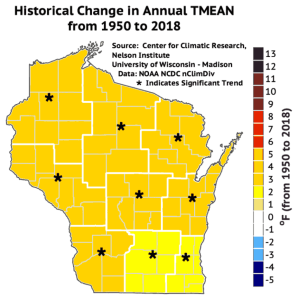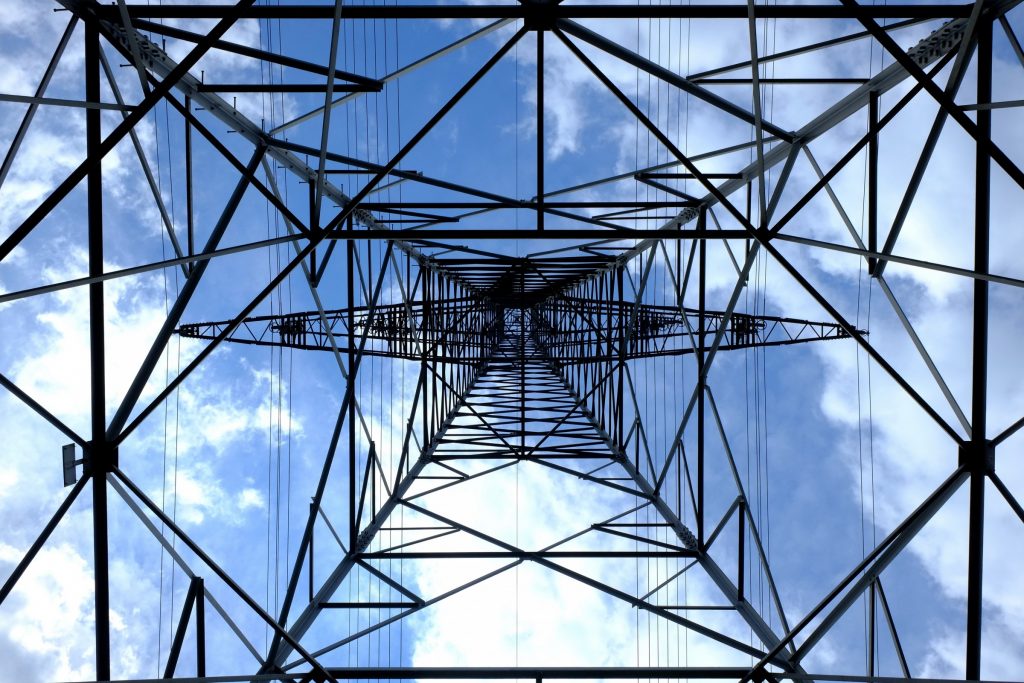Home » Community Climate Resilience Menu » Explore Our Menus » Built & Natural Environment Menu » Warming Temperatures
Warming Temperatures

Wisconsin has become 2.1ºF warmer since the 1950s as determined by the Wisconsin Initiative on Climate Change (WICCI). Within Wisconsin, increases in temperatures have not been consistent throughout the state, seasons, or times of the day. Trends show the greatest warming has occurred during winter and at night. An increase in the frequency in temperatures above 90ºF has been observed and is projected to occur with even greater frequency in the future.
Communities can choose how they respond to these warmer trends and associated impacts. The ways in which we design and build our communities and manage natural resources can reduce the negative effects of the warming climate. However, without the proper thought and planning, a continuation of existing strategies may worsen the problems.
Who and What Will be Affected
Changes in Winter Ice and Snow
Warmer winter temperatures have led to increasing freeze/thaw events in the state and winter precipitation in the form of rain mixed with snow. This leads to icier conditions affecting the built environment and challenges for plants and animals that are dependent on protection from insulating snow during the winter. Lack of sufficient snow cover on the ground can also create problems with septic systems and below-ground infrastructure. During warmer winters, ice-covered sidewalks, roads, power lines, and rooftops may need to be managed differently than under snow cover.
Conversely, warmer temperatures in the winter may also create unstable ice conditions on water bodies used for recreation or transportation in the case of “ice roads.” Changes in snow amounts has a direct effect on the winter recreation and the management of snowmobile, ATV, and cross country ski trails. In some areas of the state, winter tree harvests that are conducted when wet soils are frozen may need to be postponed if the ground remains unsuitable for vehicles.
Urban Heat Island Effects
“Heat islands” are locations where air temperatures are much warmer than in surrounding areas. Heat island effects occur in built areas during the summer when pavement and building materials store and radiate heat, trees and other vegetative cover do not provide sufficient shading, fossil fuel combustion is concentrated, and consecutive days of high temperatures occur. During these conditions, roads can buckle and air quality is reduced. Heat-related illnesses and even deaths can occur, especially with higher-risk populations. Inequitable impacts may be felt by people who live or work in poorly insulated buildings or are homeless, lack access to fans and air conditioning, are unable to pay for higher electricity bills, and rely on pedestrians and other forms of uncooled transportation.
Programs that increase insulation within structures, green roofs, shade and greenspace, renewable energy, and assistance for the cost of cooling devices and electricity should be considered. Shaded bicycle and pedestrian transportation corridors and public transit will reduce stress for people living, working, and playing in heat islands. Ensuring access to the internet will allow people in at-risk populations to do business, access food and medical advice, and communicate with others from home. Locating cooling shelters within access of vulnerable populations will also benefit the whole community.
Nighttime Temperatures
Throughout Wisconsin, nighttime temperatures are increasing faster than daytime temperatures. Hot nights reduce the quality of sleep and may even lead to heat-induced illnesses or in some cases, death. In the United States, heat-related deaths remain the “number one weather killer,” according to the National Weather Service. These weather events most affect a community’s most vulnerable populations, such as people who are homeless. Increases in electricity needed to operate fans and air conditions further strain lower-income budgets, particularly when shade trees and ground vegetation are lacking and structures become warmer during the day.
Greater Energy Consumption
As temperatures increase and people reach to increase their use of air conditioning and fans. Energy systems become overloaded. This can lead to brown-outs or rolling black-outs. Diversified energy sources and systems, community energy, and micro-grids can increase resiliency for households, businesses, and municipalities. See the Energy theme for more ideas.
Explore Related Menu
Forested Land
Increasing temperatures can increase the frequency and intensity of disturbances to forests such as wildfires, insects and disease outbreaks, and storms. Increased heat can cause the loss of individual trees or habitats may become too warm to support a tree species. These disturbances can impact the entire forest ecosystem, influencing wildlife food and habitats, sub-canopy vegetation, soil erosion, and water quality and water temperature. Wisconsin’s economy is tied to the sustainability of its forests which provide environmental, economic, recreational, and cultural benefits.
With more than 17 million acres of forested land covering nearly half the state, forested land in Wisconsin stores more than 1.5 billion tons of carbon. Selecting resilient tree species and managing forested land with climate change in mind can provide social and economic benefits, increase carbon storage and contribute to local and regional climate resiliency. Visit the Wisconsin Initiative on Climate Change (WICCI) Forestry Working Group Report for additional information about climate change and forests.
Ecosystems and Wildlife
Forests, grasslands, wetlands, and water bodies provide the structure for a variety of ecosystems and as these structures are altered by climate change, cascading impacts occur, affecting additional plants and animals. Communities can take measures to lessen some of the impacts that may otherwise result in loss of lives or species, the establishment of invasive species, and loss of recreational opportunities. Visit the Wisconsin Initiative on Climate Change (WICCI) Plant and Natural Communities Group Report for additional information about climate change, ecosystems, and wildlife.
Explore Our Menu
Equity & Environmental Justice
Equity & Environmental Justice – Equity and justice should be included with each part of the menu. As you explore each menu, consider the most vulnerable populations within your community. Be sure to include and prioritize these groups as you develop and plan your efforts.
View Equity & Environmental Justice
- Recognize low-income and underrepresented areas and evaluate proximity to greenspace and tree canopy in these neighborhoods – consider tree planting and planning for parks and greenspace:
- Equitably involve marginalized youth in conservation efforts:
- Work with local utilities to provide assistance for increased electricity bills and ensure electricity is not cut off for non-payment of electrical bills.
- A diverse group of collaborators representing tribal, academic, intertribal and government entities in Minnesota, Wisconsin and Michigan, developed a framework to integrate indigenous and traditional knowledge, culture, language and history into the climate adaptation planning process.
Education & Information
Education & Information – provide education and information ideas and resources. These are intended to be some of the first steps a community can take to address certain subsections.
View Education & Information
- Check current and projected temperature changes and climate variables in Wisconsin:
- Learn about the effects of overheating, heatstroke, and heat-related illnesses, social disparities, and disproportionate social impacts:
- Learn about climate health impacts related to heat:
- Heat stress resources for communities, species, and ecosystems:
- Explore hazards, assess vulnerability and risk, investigate options, prioritize and plan, take action:
- Plan for preparedness and response to extreme heat events:
- Reduce heat islands:
- Reduce local air pollutants to improve health outcomes:
- Explore your urban forest:
- Explore urban forest management strategies:
- Learn about the benefits of carbon sequestration and potential forest management tax incentives:
- Explore maps that identify high-risk neighborhoods and populations to heat events:
- Learn about resilient landscapes and wildlife adaptation:
Low-Cost Strategies
Low-Cost Strategies – are focused on strategies and accompanying resources that usually will not require intensive staff capacity, fiscal resources, and maybe done through staff decisions.
View Low-Cost Strategies
- Raise awareness and communicate to residents about cooling center options and locations.
- Create a user-friendly and publicly accessible map of cooling centers, like this one from Minnesota:
- Increase shade from tree canopies through tree planting in neighborhoods and downtown areas:
- Check out this case study in Chicago for ideas on how to start a tree-planting initiative:
- Plan for tree and plant species that can survive a wide range of temperatures:
- Address the changes in growing degree days, plant hardiness zones, and heat zones in the region:
- Assess the resilience of landscapes to climate change:
- Develop and publicize building weatherization programs for lower-income residents:
- Create access to community solar energy:
- Clean Energy States Alliance:
Significant Resource Deployment
Significant Resource Deployment – are strategies that may require more staff capacity, increased fiscal resources, and larger, possibly cohesive decisions.
View Significant Resource Deployment
- Reduce temperatures and improve air quality using green rooftops.
- Review a list of resources for using low-impact, reflective materials:
- Make public and mass transit alternatives accessible and affordable in order to improve air quality and reduce ozone (reduce urban heat island effect and improve human health):
- Retrofit an existing building to be designated as a cooling center:
- Prepare cooling shelters in your community:
- Refine forest management practices to increase adaptation:
- Invest in renewable energy for commercial and governmental buildings, incentivize solar panel investment for residents:
- Technical assistance for tribes to evaluate and develop renewable energy resources and reduce energy consumption:
Celebrating Successes
Celebrating Successes – are actions and strategies for communities to celebrate and keep the momentum going. They will help address positive outcomes of previous strategies taken and inspire further action.
View Celebrating Successes
- Host events celebrating successful projects that highlight climate mitigation and adaptation practices, such as a new cooling center.
Grants & Funding
Grants & Funding – help communities support actions through financial means such as grants and other resources.
View Grants & Funding
- Urban forestry grants to cities, villages, towns, counties, tribes, and non-profit organizations:
- Financial assistance programs through Natural Resources Conservation Service (NRCS):
- Preserve important natural communities, protect water quality and fisheries, and expand opportunities for outdoor recreation:
- Funding for a variety of activities related to improving transportation assets, including pedestrian and bicycle facilities, environmental mitigation, and recreational trail projects:
- Initiatives that assist families with energy costs:
- Building efficiency and renewable energy funding programs:
- Financial assistance for tribes to evaluate and develop renewable energy resources and reduce energy consumption:






